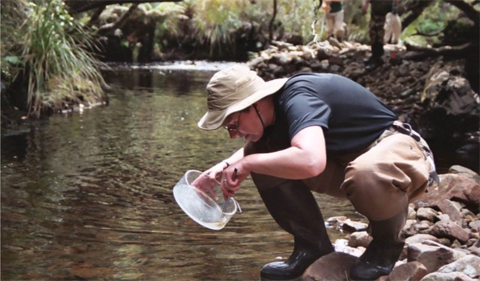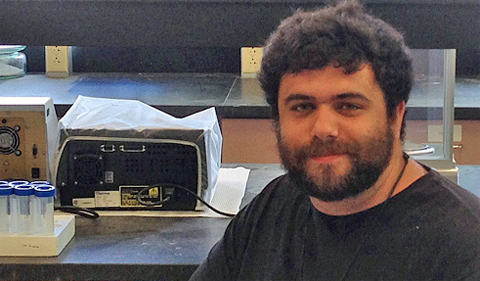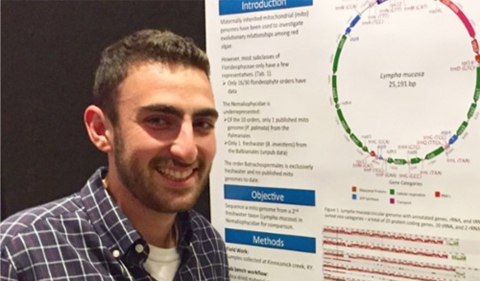Dr. Morgan Vis, and two graduate students presented research on freshwater red algae at the Phycological Society of America’s annual meeting June 4-8 at Monterey, CA.

Dr. Morgan Vis Vis examines a freshwater red algae find.
Vis, Professor and Chair of Environmental & Plant Biology, presented a talk on “Biogeographic trends in Freshwater Red Algae.”
Abstract: Molecular systematics research has revealed new taxonomic insights for freshwater red algae. These studies examined specimens from various parts of the world and so may also inform our understanding of the biogeography of genera and species. The genera can be categorized into two groups: (1) cosmopolitan, taxa that are widespread within and among more than one continent or (2) restricted, taxa that have only been reported from a single continent and are typically geographically restricted on that continent. Examining genera for which there are data, it appears that approx. two-thirds are cosmopolitan and one-third are restricted. North America, South America, Australia, Europe and Africa each have at least one genus restricted to that continent such that no one continent has a large number of endemic genera. Most of the cosmopolitan genera are present on at least three continents. Within genera, the species may have divergent biogeographic patterns with some being cosmopolitan and restricted as defined above. In addition, there are disjunct species being common on one continent, but restricted on another or on both. For genera with more than two species, approx. one-third has a single cosmopolitan species with all other species being restricted or disjunct. The other two-thirds have species with similar geographic distributions. This current analysis provides new insights, but also highlights under-sampled taxa/regions that could be the basis for future studies.

Joshua Evans
Josh Evans, Environmental & Plant Biology M.S. graduate student, presented a talk on “Plastid Genomics and Gene Expression analysis of Lympha mucosa gen. et sp. prov. Exposed to low and high light,” co-authored with Vis.
Abstract: Red algal plastids retain features reminiscent of Cyanobacteria, such as unstacked thylakoids and phycobiliproteins that make up the light-harvesting phycobilisome. Wavelengths of visible light captured by red algal phycobilisomes allow them to occupy light-depleted environments. Most red algae are marine, but ~5% occur in freshwater environments that experience dynamic seasonal fluxes in light availability. Proposed hypotheses for their acclimation to these light dynamics include changes in phycobiliprotein ratios and phycobilisome abundance per cell. To explore potential transcriptional regulation for photoacclimation in freshwater red algae, plastid genomics and gene expression assays were performed for Lympha mucosa gen. et sp. prov. Specimens were collected either from the river midsection (i.e., sun-adapted) or along edges under the tree canopy (i.e., shade-adapted). Samples were divided equally into two light treatments (i.e., low or high light) for three days. A draft plastome assembly (~183,695 bp) provided sequence data for four genes encoding alpha-subunits of the phycobilisome proteins and photosystems, and one gene for electron transfer. A nuclear-encoded apoprotein (RedCAP), known only in the red lineage, was included for analysis. Relative transcriptional abundance was measured with qRT-PCR and compared among treatments to discern genetic regulation for photoacclimation. These data serve as the first expression dataset for a freshwater red alga.

Danny Wolf at Phycological Society of America, Monterrey, CA
Danny Wolf, Environmental & Plant Biology M.S. graduate student, also presented a poster on “Mitochondrial Genome of Lympha mucosa gen. et sp. prov. (Batrachospermales, Rhodophyta),” co-authored with Evans and Vis.
Abstract: Although most Rhodophyta are marine, there is ~5% that inhabit freshwater. The majority of these freshwater reds are within the Batrachospermales. There have been a few studies of red algae, which have provided data on whole mitochondrial genomes. To date, no mitochondrial genome of a freshwater red alga has been published and only one in the Nemaliophycidae for Palmaria palmata. Therefore, the current study was initiated to provide a mitochondrial genome of a freshwater florideophyte Lympha mucosa gen. et sp. prov. as a second genome in the Nemaliophycidae and for comparison with marine rhodophytes. Sequencing was conducted using the Illumina Miseq and assembled with CLC workbench. The circular genome (~ 26,000 bp) was confirmed and annotated using previously published mitochondrial genomes in the Florideophyceae. Gene content (~ 50) and arrangement was compared to the mitochondrial genomes of Nemaliophycidae and Rhodymeniophycidae. Although annotated in this genome, the protein coding ymf39 and rpl20 sequences were highly divergent when compared to other red algae. These genes require further RNA study to verify that they produce functional products.



















Comments